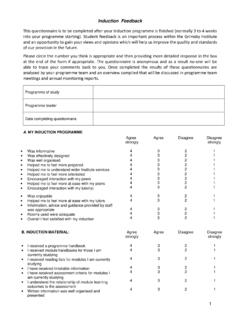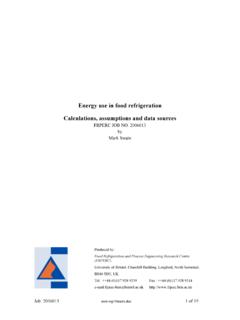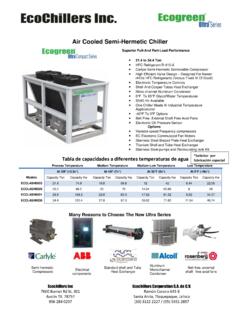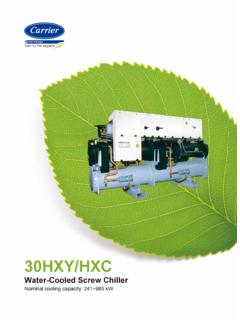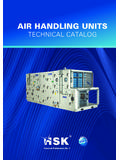Transcription of Energy use in the chilled food sector Case study – Air ...
1 Energy use in the chilled food sector Case study Air blast chilling of solid / liquid food mixtures ( pie fillings ) FRPERC JOB NO. 2006013 Report finalised Feb-2009 Mark J. Swain Produced by: food Refrigeration and Process Engineering Research Centre (FRPERC), University of Bristol, Churchill Building, Langford, North Somerset, BS40 5DU, UK Tel : ++44 (0)117 928 9239 Fax : ++44 (0)117 928 9314 e-mail Summary A study has been carried out of the pie filling air blast chilling operation at a pie manufacturing plant in the UK. The aim of the case study was to provide data on Energy consumption in the air blast chilling of hot solid / liquid food mixtures (specifically pie fillings ) post cooking under real use conditions in a manufacturing environment.
2 Detailed data was also required for verification of the LSBU/FRPERC refrigeration model, which required trials under more controlled conditions (not during normal production). The mean specific Energy consumption over the sampled production period was kWh/tonne. Specific Energy consumption was lowest ( kWh/tonne) on the day of highest production, indicating that once the chiller is switched on and cooled down at the beginning of the day (fixed overhead) efficiency will be improved the longer it can be used to usefully chill pie fillings short production runs are less efficient in terms of blast chiller Energy consumption.
3 The mean Energy coefficient (EC) of the air blast chilling process was , which is poor compared to values up to for forced air coolers published in 2001. A comprehensive set of data for validating the LSBU/FRPERC refrigeration model is presented, which were obtained under controlled conditions in the factory. It is anticipated that the model will aid system optimisation of the existing air blast system. The baseline power consumption required just to keep the air blast chiller cold, without any food product load was approximately 5 kW. Evaporator fans alone consumed up to 30% of the baseline power consumption. Analysis of the recorded temperature data revealed lower than expected evaporating temperatures for a blast chilling process (saturation temperature approximately -15 C).
4 Increasing the evaporation temperature would offer significant Energy savings. Removing the evaporator fan power (direct and indirect) from the process of cooling hot products would make a significant contribution to increasing overall Energy efficiency. Both vacuum cooling and some form of direct contact cooling system are two alternative methods that offer this advantage. However, there appears to be little hard evidence of direct measurements related to the Energy efficiency of food cooling (especially solid / liquid food mixtures ) that can be used with any certainty to provide guidance to the food industry.
5 The predicted rate of temperature fall, using the refrigeration model, closely follows the measured data. The maximum difference between the predicted and measured mean centre tray temperature at any time is C, the average difference is C. The difference between the predicted ( kWh) and measured (64 kWh) overall Energy consumption is kWh, an 8 % difference. The base load the average power used without any food product was predicted to be kW and the measured value kW, a 9 % difference. Contents Process Components of blast Specific Energy Efficiency of air blast chilling Recording of air blast chiller Data collection for model Results and Specific Energy Efficiency of air blast chilling Data obtained from validation Baseline power consumption (steady state).
6 24 Evaporating Validation 24 Specific Energy Efficiency of air blast chilling Validation Baseline power consumption (steady state)..27 Evaporating Comparison with Introduction The cooked chilled food sector is a major and growing user of Energy for refrigeration in the food industry. After cooking the air blast chilling of hot solid / liquid food mixtures is common to many processes within the food manufacturing industry, not least the ready meal and pie manufacturing sectors. However, there is little, if any detailed data available on the Energy consumed by air blast chilling systems under real use conditions in the UK.
7 In the first part of this study , the primary aim was to provide data on Energy used in the air blast chilling of hot solid / liquid food mixtures (more specifically a range of hot pie fillings ) post cooking under real use conditions (typical production) in a manufacturing environment. The data gathered provides a benchmark for comparison with other blast chilling operations. In the second part of this study , the primary aim was to collect detailed data of the same air blast chilling operation to validate the LSBU/FRPERC refrigeration computer model under more controlled conditions. The site was chosen for the study as it is an example of an air blast chilling operation of solid / liquid food mixtures that require cooling post cooking.
8 FRPERC has also a built up a good relationship with the pie manufacturing company providing the benefit of unrestricted access to plant and manufacturing data. Process description The specification of the pie filling blast chilling operation requires that trays of hot pie filling mix are cooled immediately post cooking, having reached a minimum temperature of 75 C, down to a final chilled temperature of below 5 C. Batches (approximately 60 kg) of a range of different pie fillings are cooked and then transferred into stainless steel trays, covered with cling film and stacked into trolleys. Each trolley accommodates two columns of 14 trays.
9 Each tray is filled with approximately 8 kg of cooked product (mean weight of empty tray = kg). Once each trolley is fully loaded with 28 trays of hot product, it is wheeled into the air blast chiller for cooling to below 5 C (taking approximately 6 h). The chiller can accommodate up to three trolleys at a time. Trolleys enter the air blast chilling tunnel through the entrance door at one end (Figure 1) and are incremented through in single file until they are removed through the exit door at the other end. Note evaporator coil and fans (covered by mesh) on left hand side of trolley. Figure 1. Pie filling air blast chiller entrance door end view Components of blast chiller The air blast chiller is a modified Foster unit of a type that is no longer manufactured and its original specification is unknown.
10 A plan view of the chiller and fan/evaporator coil configuration are shown in Figure 2. Refrigeration is provided by a remote compressor (Figure 3), housed in an outside enclosure below the wall-mounted condenser (Figure 4). Compressor Prestcold semi-hermetic, R1500/0138 S/D, 380/420 VAC, 3-phase, 32 FLA, 40 LRA Condenser Dry air cooled condenser unit with a single constant speed fan Width = 66 cm Height = 77 cm Depth = 36 cm Coil pipe = mm O/D Coil length = 30 rows by 6 deep Fin spacing = 8 per inch (Aluminium) Mean face velocity (Air on) = Evaporator dimensions Width = 66 cm Height = cm Depth = 30 cm Coil pipe = mm O/D Coil length = 60 rows by 4 deep Fin spacing = 8 per inch (Aluminium) Mean face velocity (Air on) = Pipe lengths Evaporator to compressor = m x mm O/D (Armaflex insulation = 15 mm thick)

